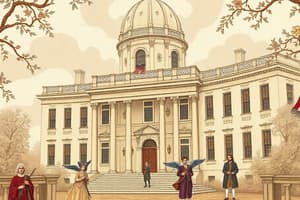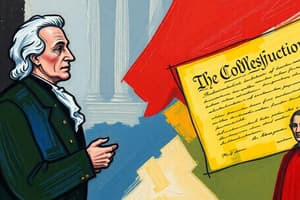Podcast
Questions and Answers
What was the primary argument made by the Antifederalists regarding the structure of the U.S. government?
What was the primary argument made by the Antifederalists regarding the structure of the U.S. government?
The Antifederalists argued for a strong state government and a Bill of Rights to limit the power of the national government.
Explain the significance of Mendez v. Westminster (1947) in the context of U.S. history.
Explain the significance of Mendez v. Westminster (1947) in the context of U.S. history.
Mendez v. Westminster challenged school segregation in California and set a precedent for the landmark Brown v. Board of Education case, which outlawed segregation in public schools nationwide.
What is the concept of a 'living Constitution' and how does it relate to the interpretation of the U.S. Constitution?
What is the concept of a 'living Constitution' and how does it relate to the interpretation of the U.S. Constitution?
A 'living Constitution' recognizes that the interpretation of the Constitution evolves over time based on changing societal values and contemporary needs.
Describe the role of the Full Faith and Credit Clause in the relationship between states within the U.S. system.
Describe the role of the Full Faith and Credit Clause in the relationship between states within the U.S. system.
Explain the significance of bicameralism as a system of government in relation to the U.S. Congress.
Explain the significance of bicameralism as a system of government in relation to the U.S. Congress.
Explain the significance of the Supremacy Clause in the U.S. Constitution in relation to the balance of power between the federal and state governments.
Explain the significance of the Supremacy Clause in the U.S. Constitution in relation to the balance of power between the federal and state governments.
Describe the main argument of the Anti-Federalists during the debate over the ratification of the Constitution and explain how it relates to the Bill of Rights.
Describe the main argument of the Anti-Federalists during the debate over the ratification of the Constitution and explain how it relates to the Bill of Rights.
What is the key difference between a civil liberty and a civil right?
What is the key difference between a civil liberty and a civil right?
What are the main characteristics of a totalitarian government, and provide an example of a totalitarian regime in history.
What are the main characteristics of a totalitarian government, and provide an example of a totalitarian regime in history.
Discuss the concept of federalism in the U.S. government, providing an example of a policy area where both state and federal governments have authority.
Discuss the concept of federalism in the U.S. government, providing an example of a policy area where both state and federal governments have authority.
What is the central concept of direct democracy, and how does it differ from representative democracy?
What is the central concept of direct democracy, and how does it differ from representative democracy?
Explain the difference between an autocracy and an oligarchy, and provide an example of each from history.
Explain the difference between an autocracy and an oligarchy, and provide an example of each from history.
Describe the significance of the Supreme Court's decision in Obergefell v. Hodges (2015) in relation to the evolution of civil rights in the U.S.
Describe the significance of the Supreme Court's decision in Obergefell v. Hodges (2015) in relation to the evolution of civil rights in the U.S.
Explain how the Dred Scott v. Sandford (1857) decision contributed to the tensions leading to the Civil War.
Explain how the Dred Scott v. Sandford (1857) decision contributed to the tensions leading to the Civil War.
What was the purpose of Jim Crow laws, and what was their significance in the South?
What was the purpose of Jim Crow laws, and what was their significance in the South?
What is the significance of the 'wall of separation' between church and state, and where is this principle found in the Constitution?
What is the significance of the 'wall of separation' between church and state, and where is this principle found in the Constitution?
Explain the concept of the Elastic Clause and its importance in understanding congressional power.
Explain the concept of the Elastic Clause and its importance in understanding congressional power.
How did the Three-Fifths Compromise impact the representation of enslaved people in the United States?
How did the Three-Fifths Compromise impact the representation of enslaved people in the United States?
How did Plessy v. Ferguson (1896) impact racial segregation in America, and what was its central principle?
How did Plessy v. Ferguson (1896) impact racial segregation in America, and what was its central principle?
What is political efficacy, and why is it important for a healthy democracy?
What is political efficacy, and why is it important for a healthy democracy?
Describe the key features of the Great Compromise, and why was it significant in the Constitutional Convention?
Describe the key features of the Great Compromise, and why was it significant in the Constitutional Convention?
Flashcards
Supremacy Clause
Supremacy Clause
Establishes the Constitution, federal laws, and treaties as the highest law.
DACA
DACA
Policy allowing some childhood arrivals in the U.S. to defer deportation.
Civil Liberties
Civil Liberties
Personal freedoms protected from government interference.
Federalism
Federalism
Signup and view all the flashcards
Totalitarian Government
Totalitarian Government
Signup and view all the flashcards
Confederation
Confederation
Signup and view all the flashcards
Oligarchy
Oligarchy
Signup and view all the flashcards
Home Rule
Home Rule
Signup and view all the flashcards
César Chávez
César Chávez
Signup and view all the flashcards
Bill of Rights
Bill of Rights
Signup and view all the flashcards
Eminent Domain
Eminent Domain
Signup and view all the flashcards
Intergovernmental Relations
Intergovernmental Relations
Signup and view all the flashcards
Living Constitution
Living Constitution
Signup and view all the flashcards
Sanford Decision
Sanford Decision
Signup and view all the flashcards
Jim Crow Laws
Jim Crow Laws
Signup and view all the flashcards
Establishment Clause
Establishment Clause
Signup and view all the flashcards
Three-Fifths Compromise
Three-Fifths Compromise
Signup and view all the flashcards
Brown v. Board of Education
Brown v. Board of Education
Signup and view all the flashcards
Civil Rights Act of 1964
Civil Rights Act of 1964
Signup and view all the flashcards
Seneca Falls Convention
Seneca Falls Convention
Signup and view all the flashcards
Block Grants
Block Grants
Signup and view all the flashcards
Study Notes
American Government Exam 1 Review
-
Supremacy Clause: The Constitution, federal laws, and treaties are the supreme law of the land.
-
Deferred Action for Childhood Arrivals (DACA): A U.S. immigration policy allowing some children brought to the country to receive a renewable two-year period of deferred action from deportation and eligibility for a work permit.
-
Me-Too Movement: A social movement against sexual harassment and sexual assault, highlighting prevalence and empowering survivors.
-
Anti-Federalists Concerns: Their main concern was the Constitution giving too much power to the national government and lacking a Bill of Rights.
-
Direct Democracy: Citizens directly vote on laws and policies, rather than through elected representatives.
-
Government Definition: The institutions and procedures through which a territory and its people are governed.
-
Civil Liberties: Constitutionally protected aspects of personal freedom from government interference.
-
Federalism: A system where power is divided between a central government and regional governments (states).
-
Civil Liberties vs Civil Rights: Civil liberties protect from government actions, while civil rights protect from discriminatory treatment.
-
Totalitarian Government: A government not constrained by legal limits and aims to eliminate challenges to its authority.
-
Confederation: A system where member states retain most sovereign authority and delegate limited powers to a weak central body.
-
Articles of Confederation: The first written constitution of the United States.
-
Anti-Federalists: During the founding era, these were the strongest supporters of adding the Bill of Rights to the Constitution.
-
Home Rule: When a state grants a city the power to govern its own local affairs.
-
Oligarchy: A form of government where a small group (often landowners, military officers, or wealthy merchants) controls most governing decisions.
-
Autocracy: A system where one person holds absolute power, such as a king or dictator.
-
Obergefell v. Hodges (2015): A significant Supreme Court decision that legalized same-sex marriage nationwide.
-
Dred Scott v. Sanford (1857): A Supreme Court decision declaring that African Americans were not U.S. citizens, escalating pre-Civil War tensions.
-
Jim Crow Laws: State and local laws in the Southern United States that enforced racial segregation.
-
Civil Rights: Legal and political rights safeguarding individuals from discrimination by the government or others.
-
Establishment Clause: Part of the First Amendment that establishes a separation between church and state.
-
Elastic Clause: Grants Congress the power to make all laws "necessary and proper" to carry out its enumerated powers.
-
Three-Fifths Compromise: An agreement at the Constitutional Convention counting enslaved people as three-fifths of a person for representation and taxation.
-
Plessy v. Ferguson (1896): Introduced the "separate but equal" rule, justifying racial segregation.
-
Political Efficacy: The belief that citizens can influence government actions.
-
Great Compromise: Each state has an equal number of senators (regardless of population) and House representation linked to population.
-
Brown v. Board of Education (1954): The Supreme Court ruling declaring racial segregation in public schools unconstitutional.
-
Civil Rights Act of 1964: Legislation banning discrimination based on race, color, religion, sex, or national origin.
-
Great Depression and New Deal: Events greatly influenced the expansion of the national government
-
Indian Citizenship Act of 1924: Granted U.S. citizenship to Native Americans.
-
Preemption: Federal government overriding state or local laws in specific areas.
-
Legislative, Executive, and Judicial Branches: The three branches of the U.S. Federal government.
-
Seneca Falls Convention (1848): The first women's rights convention in the United States, advocating for women's suffrage.
-
Declaration of Independence and U.S. Constitution: Essential documents of the American Founding.
-
Block Grants: Federal funds provided to states with general spending guidelines.
-
New Federalism: Efforts by presidents to return power to the states.
-
César Chávez: Leader of the United Farm Workers union.
-
Internment of Japanese Americans: Acknowledged as a "grave injustice" in 1988 with the Civil Liberties Act.
-
Bill of Rights: The first 10 amendments to the U.S. Constitution.
-
Mendez v. Westminster (1947): A Supreme Court case that challenged school segregation, establishing precedent for Brown v. Board of Education.
-
Antifederalists: Argued that the powers of the national government should be limited by a Bill of Rights and strong state governments.
-
Federal Government Expansion: Expanded after 1933 to handle the Great Depression and the New Deal.
-
Unitary System: A centralized form of government where lower levels have minimal independent power.
-
Eminent Domain: Government power to take private property for public use with compensation.
-
Dual Federalism: A form of federalism emphasizing state and federal government separation. This lasted from the founding until the 1930s.
-
Full Faith and Credit Clause: A clause requiring states to recognize public acts, records, and judicial proceedings of other states.
-
Intergovernmental Relations: Negotiations between local, state, and federal governments regarding policy.
-
Bicameralism: Principle of dividing a legislature into two chambers, exemplified by the U.S. Congress.
-
Living Constitution: Means that its interpretation evolves over time based on contemporary needs
-
Declaration of Independence: Declared life, liberty, and the pursuit of happiness as inalienable rights.
-
Good U.S. Citizen: Critically an informed and active participant in government.
-
Pharmacists' Refusal to Sell Birth Control: May infringe upon a woman's right to privacy and equal access to healthcare.
-
Republic/Representative Democracy: A government system where citizens elect representatives to make decisions on their behalf.
Studying That Suits You
Use AI to generate personalized quizzes and flashcards to suit your learning preferences.



